#700-Year-Old Inuit Stones
Text
The Last Flower At The Top of The World—and The Perilous Journey To Reach It
Scientists Journeyed to a Stretch of Gravel Off The Coast of Greenland—The Farthest North You Can Go and Still Walk on Land. These Photos Show What They Found There.
— By Sarah Gibbens | Photographs byJeff Kerby | May 08, 2024
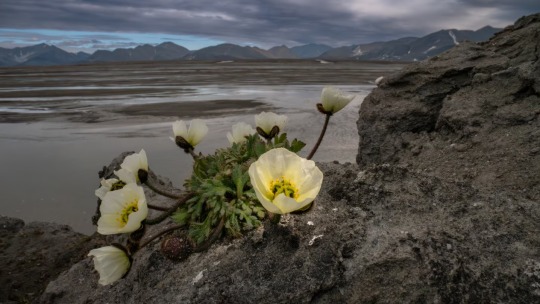
An Arctic Poppy thrives on the Northern Coast of Greenland. Among the plant life in this region, these hardy Flowers are like Giants. Some, like this one, grow in clumps that protect themselves from harsh weather. Like a satellite dish, they will slowly turn to follow the sun. On an expedition to understand what lives at this latitude, an Arctic Poppy like this was found about 20 inches south of the World's Northernmost Plant.
At the top of the Earth, the northernmost stretch of land a person can stand on is Inuit Qeqertaat, also named Kaffeklubben Island by early 20th Century Danish Explorers. The region is a dark gray stretch of gravel on the northern coast of Greenland where land slowly gives way to frozen sea ice.
To find what lives amid these rocky soils, climate change researchers and National Geographic Explorers Brian Buma and Jeff Kerby and their team embarked on a journey to survey the region. There, they found a common species of moss (Tortula Mucronifolia), the world's northernmost plant, and a yellow and lime-green Arctic poppy (Papaver Radicatum), growing just a few inches south of the moss.
On the nearby mainland, Greenlandic archaeologist Aka Simonsen discovered a ring of roughly 700-Year-Old Inuit Stones, which may be the northernmost archaeological remains.
Growing in Extremes: The Northernmost Stretch of land in the World, Inuit Qeqertaat, sits off the coast of Johannes V. Jensen Land, a Peninsula in Far Northern Greenland. National Geographic Explorer Brian Buma traveled there to find the northernmost plant-a common moss—and the northernmost flower a few inches south-an Arctic poppy.
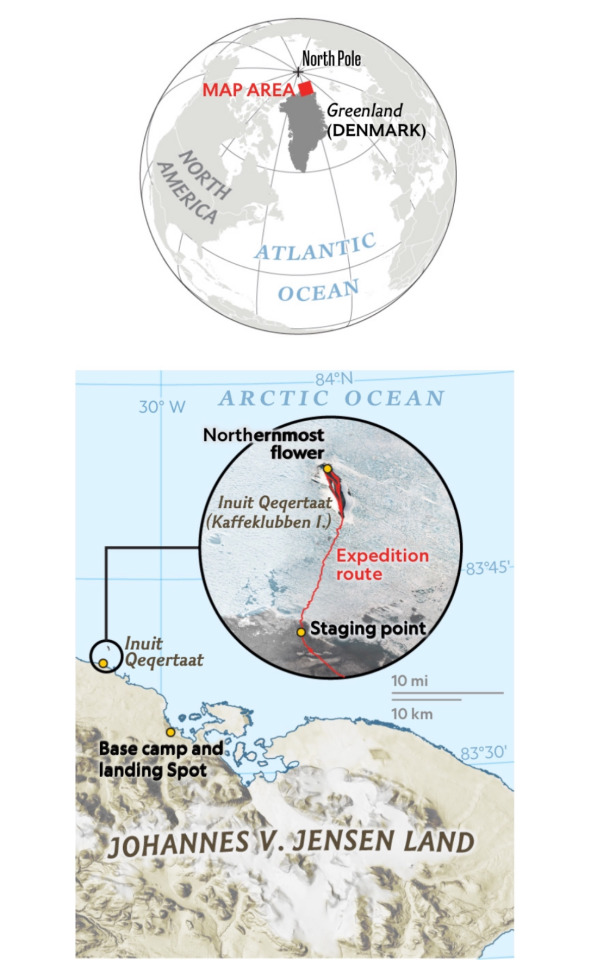
Rosemary Wardley, NGM Staff; Martin Gamache, National Geographic Society Sources: Jeff Kerby, Scott Polar Research Institute; Brian Buma, Environmental Defense Fund; SkySat imagery from July 13, 2023, Planet Labs PBC; ArcticDEM, Version 4.1
The research team left their own mark on the mainland coast, staking plots and recording the vegetation they contained to create a highly detailed digital map of the area they surveyed. Information collected from this trip will be the first data logs in what Buma and Kerby hope will be a long timeline of research in the far northern region.
Here, above the Arctic Circle, the planet is warming four times faster than anywhere else on Earth. Changes here will have ripple effects across the globe, which is why the team braved harsh conditions to find what lives on the edge.
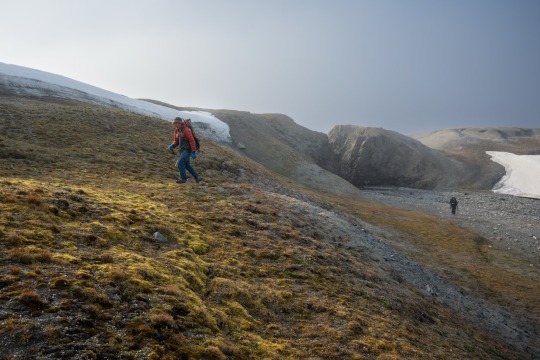
The expedition team was led by climate scientist and National Geographic Explorer Brian Buma. The north coast of Greenland was used as a staging point while shuttling gear across sea ice to Inuit Qeqertaat (Kaffeklubben Island).
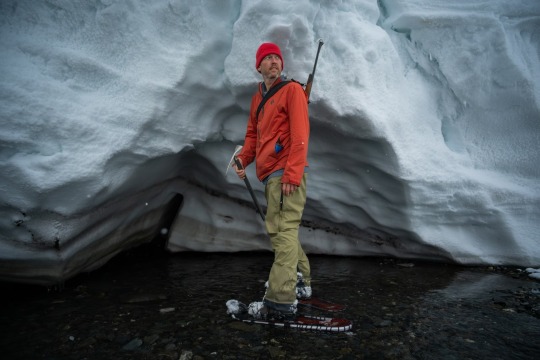
Brian Buma collected samples from different layers of this snow glacier to understand the unique properties of water in this rarely visited region. This part of the world is a polar desert, and precipitation is scant, so the samples in this glacier represent many years of snow.
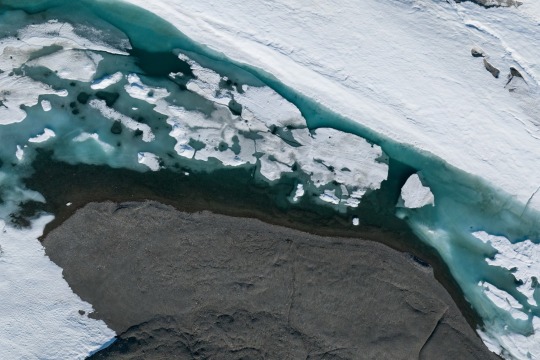
From above, the northern coast of Inuit Qeqertaat—and thus the northernmost stretch of land on Earth—is visible. It was near this shoreline that the team found the edge of terrestrial life, including a common species of moss, officially the farthest north, and the northernmost flower on earth—found about 20 inches south of the moss. The small, gravelly island is about a mile north of mainland Greenland.
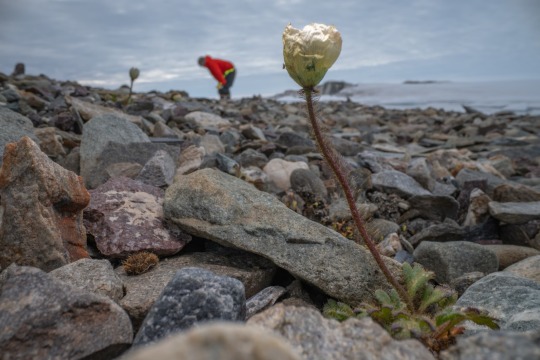
This is the northernmost flower on earth, a lone and somewhat ragged Arctic Poppy, sitting near the shoreline of Inuit Qeqertaat. Poppies dotted the northern edge, with a few purple mountain saxifrage (Saxifraga oppositifolia) only slightly farther up the slope. In the background, Brian Buma surveys various contenders for northernmost plant before a final survey determines this flower to be the official runner-up. Seen just behind the flower, a tuft of ‘Mucronate screw moss’ (Tortula mucronifolia) claims that title.

Identifying mosses and other tiny Arctic flora requires a hand lens and careful attention to detail. Up close, Brian Buma examines their adaptations to cold weather, such as small hairs coating a plant's exterior.
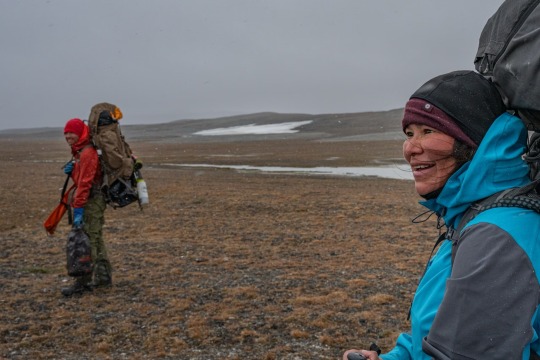
Aka Simonsen, a Greenlandic archeologist, prepares to leave camp with Brian Buma, just as the weather begins to turn. After just a few hours the northernmost island, the team left, intending to return the next day. The window to return quickly closed after a few days when bad weather turned into a storm that brought strong winds and heavy precipitation. The July storm dumped nearly a foot of snow and drifts reached several feet. Harsh conditions trapped the team at their base camp for a week.
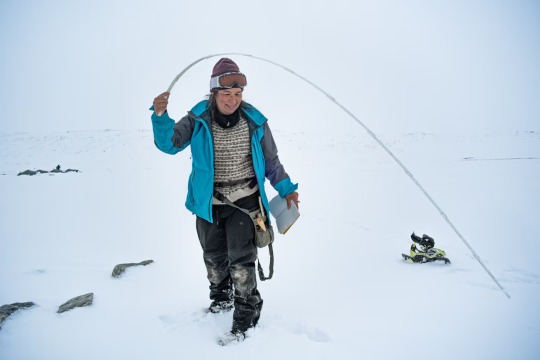
Aka Simonsen measures a ring of large stones that may have been used to anchor a tent. The stones are roughly 700 years old and likely left by the Thule people. These artifacts were found on the mainland, near the team's base camp and could be the northernmost documented archeological site on Earth.
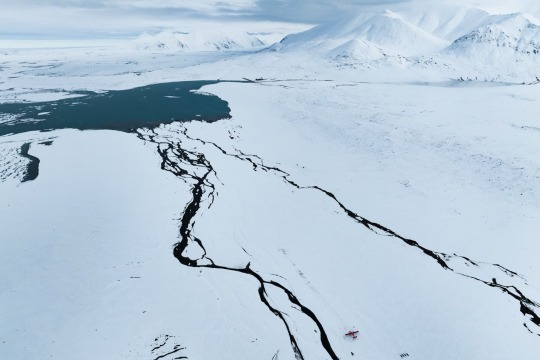
When the plane returning to retrieve the team landed, it got stuck in snow, and a makeshift runway had to be constructed by scooping snow with snow shoes. Gravel was placed by hand so the plane's tires wouldn't slip on ice or stick in snow during takeoff. Scientists who return to this northernmost region will be able to use the team's detailed digital map to chart how the ecosystem is changing as the planet warms.
#Environment#Environmental#Last Flower 🌺#Top of the World 🌎#The Perilous Journey#Scientists Journeyed | Coat of Greenland 🇬🇱#Arctic Poppy#Giant Flowers 🌺 🌸 💐#National Geographic Explorers Brian Buma | Jeff Kerby#(Tortula Mucronifolia)#Arctic poppy (Papaver Radicatum)#Inuit Qeqertaat#Kaffeklubben#20th Century Danish 🇩🇰 Explorers 🧭#700-Year-Old Inuit Stones#Johannes V. Jensen Land
16 notes
·
View notes
Text
Inuit vs Eskimo
https://www.uaf.edu/anlc/resources/inuit-eskimo/
Although the name "Eskimo" is commonly used in Alaska to refer to all Inuit and Yupik people of the world, this name is considered derogatory in many other places because it was given by non-Inuit people and was said to mean "eater of raw meat."
Linguists now believe that "Eskimo" is derived from an Ojibwa word meaning "to net snowshoes." However, the people of Canada and Greenland prefer other names. "Inuit," meaning "people," is used in most of Canada, and the language is called "Inuktitut" in eastern Canada although other local designations are used also. The Inuit people of Greenland refer to themselves as "Greenlanders" or "Kalaallit" in their language, which they call "Greenlandic" or "Kalaallisut."
Most Alaskans continue to accept the name "Eskimo," particularly because "Inuit" refers only to the Inupiat of northern Alaska, the Inuit of Canada, and the Kalaallit of Greenland, and it is not a word in the Yupik languages of Alaska and Siberia.
https://www.aaanativearts.com/alaskan-natives/eskimo-vs-inuit.htm
I answered a letter a while ago, from someone at a museum in Alaska. They wanted to know why Inuit (which I am of) dislike being called "Eskimos." After all, many Alaskans don't mind being called Eskimos, and even seem to dislike the term "Inuit" when southerners apply it them, however well-intentioned.
I am not surprised by the confusion. The ascendancy of Inuit culture, through good reportage and the establishment of Nuvavut, has conditioned southern folks to say "Inuit" instead of "Eskimo." Southerners have complied beautifully, but at last they are running up against peoples, related to Inuit, who insist that they are Eskimos. The confusion derives from this sticky fact: Inuit are not Eskimos, and Eskimos are not Inuit.
In simple terms: The first Mongolic peoples of North America (linked by genetic heritage to the Mongols of Asia) settle in Alaska as early as 8,000 years ago. Paleo-anthropologists like to call them the "Arctic Small Tool Tradition," which, frankly, is fine by me.
Millennia creak by. Some of these people move east across North America in waves. The first such Mongolic wave (I dislike the term "Mongoloid") finishes settling as far as Greenland about 4,000 years ago. Once they settle, they are dubbed the "pre-Dorset" culture, later developing into the more advanced "Dorset" culture. These are a Mongolic people from Alaska, but they live in an incredibly cold world without dog-sleds and most of the technologies Inuit are used to. Their rectangular encampments are bordered by short walls of flat stone. They are obsessed with art, particularly images of human faces, which they leave everywhere around the Arctic.
Then the Earth warms up a bit. Between the period of Europe's late dark ages to its early middle ages, about 800-1200 A.D., a new Mongolic people dubbed "Thule" sweep eastward from Alaska. They are tool-obsessed people (over 40 items in a seal-hunting kit alone), mainly following whales and walrus along newly-opened channels in the ice. These are the inventive souls who bring such innovations as dog-sleds, soapstone lamps, float bladders, igluvigak ("igloo") building, waterproof stitching, and toggling harpoons with them. By the time they have completely occupied the area from the eastern edge of Alaska to Greenland, around 700 years ago, the Earth cools again. It is time to curb the nomadism.
They supplant the Dorset, and become Inuit.
Now, I have read too many interpretations of "Inuit" as meaning, "Humans" or "The People," probably under the (incorrect) assumption that this is every culture's name for itself.
However, having been a translator for 30 years, I can guarantee you that "Inuit" is a specific term. It precisely means, "The Living Ones Who Are Here." It denotes a sense of place, of having arrived, a memory that Inuit knew they had kin somewhere else. It also betrays the fact that Inuit once knew they were not the original peoples of their lands. Interestingly, in this way does language act as a code to preserve heritage.
The Alaskan Eskimos are descended from the Mongolic peoples that continued to develop into diverse western cultures. As such, they have their own preferred words for themselves, such as, "Yup'ik" and "Aleut" and "Nunamiut." Nevertheless, none of us has completely left our heritage behind, and I still get a kick out of it when I understand the speech of people from Alaska, or even the Chukchi Peninsula.
There was only one culture in the Canadian Arctic and Greenland before Inuit. These, Inuit refer to as the "Tunit." These are Dorset. Inuit remember them well in their oral traditions. The Tunit were small, very strong, incredibly shy. It is said that Tunit taught Inuit about their lands, that they built the first inuksuit ("images of men," man-like stone structures) to herd caribou along predictable paths for hunting. Paradoxically, they were thought of as poor craftsmen.
Unfortunately, the Tunit are now extinct. Inuit, therefore, have the luxury of using "Inuit" in a wide context, since they are the only ones remaining. But even this can get politically tricky, since there are a couple of peoples adjacent to them - "Inuvialuit," for example - who do not always approve of being called Inuit. But, generally, one can get away with using "Inuit" as a kind of umbrella term for eastern Mongolic peoples.
The umbrella term for the far west, Alaska, is "Eskimo." Alaskans do not seem to mind its usage these days, simply because it provides a handy general term. And there may be another reason not to mind it, as well. The old thinking was that it derived from Cree, derogatorily meaning, "Eaters of Raw Meat." It was thought that it was overheard by French missionaries, distorted to "Esquimaux" or "Esquimau," then Anglicized to "Eskimo."
It is amazing how widespread this belief has become, so that it is cited by all but the most informed sources. Yet, while remaining a bit of a mystery, the missionary-origin of "Eskimo" is pretty much discounted today, since there is some compelling evidence that the word was existent in pre-colonial times. Some researchers have made a good case for it coming from Montagnais vocabulary, literally meaning, "snowshoe net-weaver," but culturally being a term that indicates any craftsman of great skill. It seems to me that this makes more sense and, if true, would mean that the word is not derogatory after all.
Inuit, however, can never be Eskimos. Existent in the west or not, preferred by Alaskans or not, it was simply never part of their vocabulary. Inuit, after all, have their own name for themselves: Inuit. Today, "Eskimo" only reminds Inuit of the days when missionaries kidnapped them, dumped flea powder all over them, and assigned "Eskimo numbers" to them, instead of bothering to note the proper name for the culture or the individuals within it.
It all really boils down to choice, the right to accept or reject specific labels at will, the right to be known as one wishes to be. And is that not what liberty is all about?
3 notes
·
View notes
Photo

Name: Njáll Ivorsson
Age & Date of Birth: He is actually 730 years old, but he looks 30.
Species: Half-Forest Demon
Gender: Cis Male
Orientation: Homosexual
Fandom/Original: He’s one of my other first characters from 2005!
Warnings: Death, abuse, race discrimination.
Biography: Njáll was born in Greenland to Ivor Tómasson and an unknown demon woman. Tomas raised his son by himself, and he was very proud of his child, regardless of what he was. He spent his time teaching his son important things like farming, fishing, and home skills that he could use when he was on his own. Many of the other villagers were wary of Ivor because he was a Greenland Inuit, but they were more wary of his son and they blamed a large amount of things on him. They claimed that it was because he was a demon, and all of their bad luck was coming from him. Ivor spoke to them, pleasing that his son never did anything wrong. Things got so bad that people would throw things at his son. Someone lit him on fire once, but luckily his dad stopped it.
After this incident, Ivor decided to move. He took his belonging and his child and they moved into the woods where nobody could bother them. Njáll felt like he was a burden, so he did a lot of things to help his father out around the house. Ivor didn’t want his son to feel that way, and every day he would try to make him feel better by treating him really well.
There were other villagers who still harbors hate against Ivor and his unnatural child, so out of anger, they killed someone and blamed it on Njáll. At the time there was no way to disprove the evidence, so the villagers took the boy into their custody. In prison they did a lot of weird things to him like trying an exorcism on him, they even tried religious ceremonies on him in an effort to be rid of the demon. None of this worked, and they were enraged.
As this went on, a strange ship docked in their pier. Ivor saw this as an opportunity and he went to speak to the captain. Strangely enough, the captain of the ship was a boy who looked no older than his own son. He asked the kid if he was willing to take on a new crew member, and after much convincing, the boy said yes. That day, Ivor told the villagers that he killed the person and that his son was innocent. They took this opportunity and imprisoned him while releasing Njáll. Before he went in, he told his son to bring what he needed and to go by the docks because he got him a job as a deck hand. Njáll objected, but he knew that he had to go. They warned him that if he returned then things would get worse for his father. He did as he said and he left.
Life on the ship was strange, but Captain Sterling was a kind person who made sure that Njáll was fitting in well. Njáll thought that it was strange that nobody in his crew cared weather he was a demon or not and they treated him as a friend. He felt like paying them back, so he started catching fish and other sea creatures for them to eat. They were extremely grateful and they loved all that he did. The ship then stopped in England and things got even more strange. Njáll noticed that during some times of the month, Sterling would get really sick and he would disappear. He never questioned it, but he felt like something was wrong. As he was gathering supplies, he met two girls who needed a way to get to Greece. They were really kind and they said that they were witches in training. He brought them to Sterling, who said that they could join and the new crew was on their way to Greece.
After learning that a vampire stowed away in their ship, they made their way to Greece. They made it to the island, but they were soon taken as prisoners by these large creatures that kind of looked like Njáll. The leader of the creatures was a tough woman who hated them all. Njáll noticed that there was a boy who looked just like her standing there and that he kept on staring at him. He was thrown into a different prison for a while until he was released by the red haired boy. He told him that his friends were getting ready to leave and that he would bring him to them.
The escape commenced and everyone got out safely. As they were about to sail, the boy jumped into their boat and he decided to come with them. Lailah and Najda were very welcoming of him and they felt that he would be an asset to their group. As they traveled, Njáll learned that his name was Kal and that he was growing bored in their village. The two of them became good friends and they talked to each other about their families and what they did. The group of travelers went on different missions together, and they all became really close friends.
One day as they stopped in Italy for a rest, Njáll saw Kal getting up and getting ready to leave. He wanted to ask him if he was okay, but he never got the chance to. He lost his friend and although they looked everywhere, they could not find him.
They continued with their task and for years they had never heard back from Kal. Njáll was invited to Lailah and Najda’s coronation and he was even invited to the netherworld. He enjoyed it and he decided to move there so that he could learn more about demons, but in the back of his mind he worried about his dad and Kal.
As he was in the netherworld, he got word that the death gods needed the help of demons and other beings to stop a Necromancer from escaping. He agreed and a massive force of Netherworld dwellers got ready for their attack. Lailah told him that she called for some heavy reinforcements in the form of their dragon friend, Sergei and Kal. Njáll was amazed that she managed to find them both, but he was excited to see Kal again. After a few days, Kal and Sergei arrived, and the group was reunited. After talking to each-other for a while, they all got ready for their fight.
The fight with the Necromancer was tough and in an effort to stop him, the death gods froze the netherworld in time for 700 years. Once the time passed, the Necromancer was so weak that he turned into stone. The people of the netherworld were saved and they continued to have a safe existence in the newly saved world.
Njáll and Kal reconnected and although it took him a while to admit it, Njáll told Kal that he liked him. Kal felt the same way, but he was a bit embarrassed by it. They took things slow for a while, but then after seeing that they were in an environment where their relationship was seen as acceptable, they felt more comfortable sharing their feelings with one another.
Appearance: When compared to Kal, Njáll looks more “human” than his boyfriend. Because he’s from the north, Njáll’s fur is longer, much longer on his broad tail. He has blueish fur and his hair is naturally navy blue. He’s about 8 feet tall, 620lbs, and he has a lighter frame than Kal. In his face, he strongly resembles his mother, having her large eyes, full lips, and diamond shaped face. He keeps his hair short and shaved in the back, but most of the time it’s an undercut-mohawk. When he’s not training, he wears a tank top and comfy slacks. On his left eye, he actually has the same tattoo as Kal, but his is red. This symbolizes that they are a couple.
Personality: Njáll is actually a very kind and relaxed person. His father taught him to be humble and respectful to the people that he meets. He’s always willing to listen and he’s willing to protect all of his friends from harm. He is naturally a pacifist, but if he has to fight, then he’s able to tell people what to do. He’s really good at planning and unlike Kal, he’s more willing to make technical traps and contraptions to stop the enemy.
Favourite & Least Favourite things:
Favorites: One of his favorite things is farming. He loves it so much and he’s really good at it. He also enjoys fishing and making non-lethal traps.
Least Favorites: Being underestimated, people who are rude, abusive people, and people who don’t give others a chance. Other than those things, he’s pretty chill with anything.
Strengths and Weaknesses:
Physical Strengths: He is half forest demon so like them, he’s immune to things like lightning, poisons and certain types of magic. He has a rare talent for swimming too. He also has enhanced strength, senses, speed, and combat skills.
Strengths: He’s a practical thinker. He tries to do things that will benefit both parties at times, but he’s someone who can think fast and get something done. He’s also pretty positive and he’s a really good guy.
Weaknesses: He does worry that he’s not strong enough. He knows that he’s only a half demon, and many old school demons remind him of this fact, but he’s tries his best. Sometimes he’s known to exhaust himself by doing this.
Additional notes:
7 Facts about Njáll.
A lot of people ask him this, but his name is actually pronounced as “Kneel”, but he’ll accept “Nye-jal”
He has never been good at climbing trees. He’s tried multiple times, but he can’t really do it. He can get halfway up the base, then that’s it.
When asked, he said that his favorite part of Kal’s face are his eyes. He thinks that they are really expressive and pretty.
He’s never met his mother before.
So far, he likes living in the netherworld because it’s such a different place for him. He loves the gardening and all of the new things that he can plant.
His weapon of choice is a demon sword. He’s learned how to use one of these perfectly.
His good friend is a demon named Vian. Vian is the resident archivist, and he’s really enjoyable to talk to if he’s in the mood. Other times, he’s his other self and that’s really creepy.
Specify here whether fanart/fanwork of your OC is okay!
Yes please!
#racial discrimination#death#original#murder#abuse#orientation discrimination#submission#oo! nice oc :0
3 notes
·
View notes